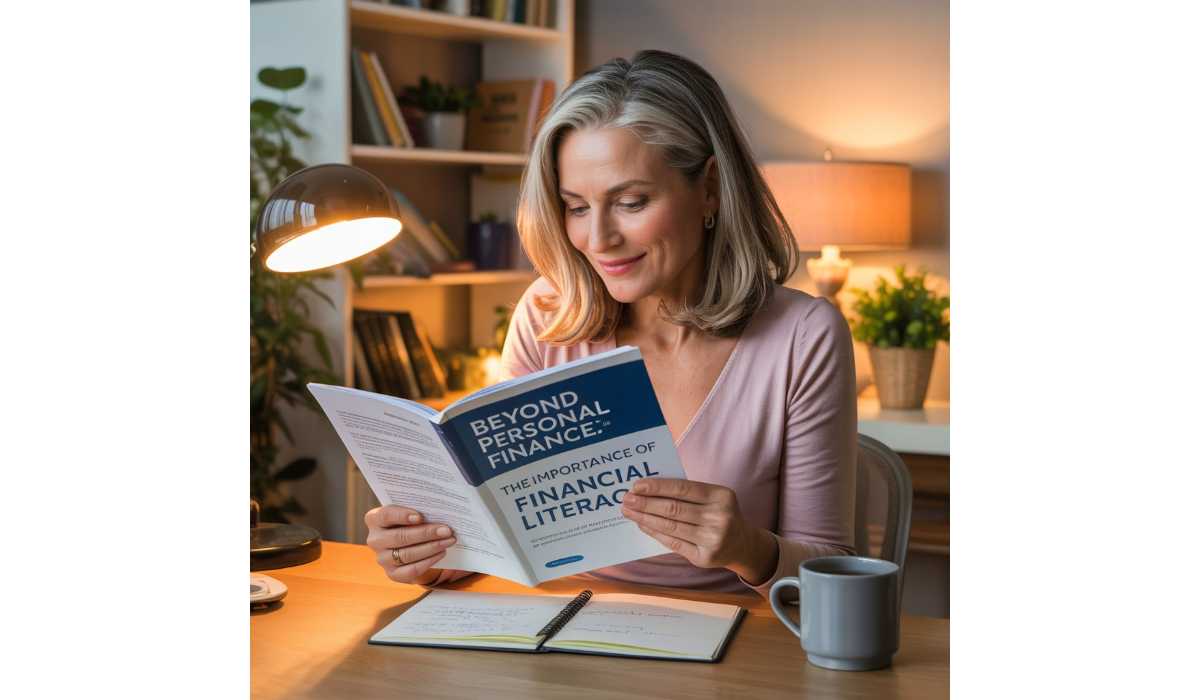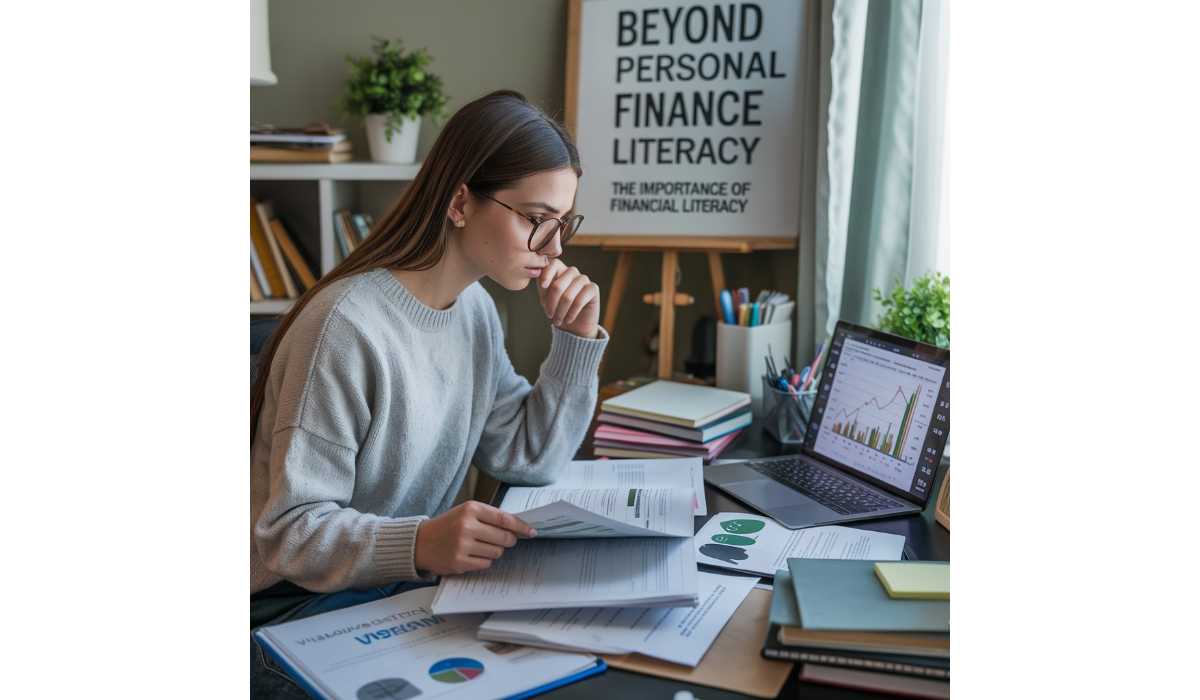Introduction: The Importance of Financial Literacy Early On
I still remember the first time I had to manage my own money. I had just started college, and within a few weeks, I had spent most of my savings on pizza, clothes, and other unnecessary items. I didn’t even know how credit cards worked, how interest could build up silently like a slow leak in a tire. No one taught me about this in high school. Sound familiar?
This is exactly why we should start teaching financial literacy before adulthood. It’s not just about knowing how to save or budget, it’s about preparing for the quick decisions of real life: choosing a job, buying a car, managing debt, and even planning for a family.
In 2025, life is more complicated than ever. Today’s teens are growing up in a world of student loans, digital payments, and the ever-increasing cost of living. If we don’t equip them now, we’ll leave them guessing later. That’s where personal finance comes in, not just theory, but life-based education. It simulates what life is like for young people, financially, giving them a chance to start. Honestly, if I had had something like this when I was a kid, it would have saved me a lot of trouble.
Sources: Jump$tart Coalition for Personal Financial Literacy
What is Beyond Personal Finance?
When I first heard about Beyond Personal Finance, I thought it was just another budgeting course. But after diving into it, I quickly realized that it was something completely different and, honestly, a lot more exciting than I expected.
This program is designed for teens and young adults, teaching them about money from a real-life perspective. Instead of boring lectures, it lets students aged 22 to 42 “live” a simulated 20-year life. They choose a career, choose a lifestyle, budget their income, and deal with whatever life throws at them. I’m talking about car incomes, rent or mortgages, investments, marriage, children, and even unexpected expenses. It’s real-life practice without the real-life risks.
What I love most is that it doesn’t just treat money as numbers; it connects money to everyday decisions. For example, if you want to be a teacher, your budget will look a lot different than if you were going into technology or healthcare. Students quickly learn how their choices shape their financial future.
There is also a tween version for kids aged 8-12, which focuses on basic money skills, such as saving, spending wisely, and understanding the difference between needs and wants. It’s colorful, fun, and perfect for getting young kids comfortable with financial terms and concepts.
Sources:
- Beyond Personal Finance Official Site – 2025 Curriculum Overview
- Council for Economic Education – Financial Education for Teens

Key Features of the Curriculum
One thing I’ve noticed about most finance courses is that they’re empty. You sit and listen; byjog cilo , pore aste aste kaj dinner time, you’ve forgotten half of it. But Beyond Personal Finance completely turns that experience on its head. It’s designed for students who don’t just want to watch, they want to do.
I’ll tell you what makes it different.
Interactive Learning That Feels Like Real Life
This is not a typical class where you sit and take notes. From the beginning, students run their own “life simulation.” They choose a career, earn a salary, and manage their monthly budget. Every choice we make, no matter how small, impacts our money. I’ve seen teens quickly realize how quickly groceries, car payments, and phone bills can eat up a paycheck. That moment of realization? It sticks with them.
Plot Twists: Because Life Happens
What makes it even more powerful is the unexpected “plot twist.” Just like in real life, you won’t see everything coming. Maybe your car will break down. Perhaps you’ll have twins instead of one baby. These curveballs teach students to think about the future, save money for emergencies, and adapt — life skills that schools often ignore.
Covers the Whole Financial Journey
This course isn’t just about basic budgeting. It goes deep into insurance, investing, housing, student loans, and even taxes. I wish I had known about deductibles and compound interest before I decided on my own. The course is clear, well-paced, and uses real-world statistics based on 2025 cost-of-living data. This makes it incredibly relevant today, especially for teens growing up in a high-inflation economy.
Flexible, Self-Paced, and Made for All Learners
Everyone learns differently, and that’s what I love about this program. Whether you’re a visual learner or someone who needs time to process things slowly, Beyond Personal Finance gives you options: videos, hands-on worksheets, colorful lesson pages, and practical activities. And the writing is large, clear, and easy on the eyes—great for kids with ADHD or learning challenges.
Even as an adult, I found some of the material engaging. This is a program built with empathy and real-world relevance.
Sources:
- Beyond Personal Finance Curriculum Highlights (2025)
- Edutopia – Learning by Doing: Why It Works
Personal Experiences and Testimonials
I always believe that the best feedback doesn’t come from ads, it comes from real people. And when I talk to parents, teachers, and even a few students about Beyond Personal Finance, their stories stand out.
“My son used to think money grew on trees. After just three lessons, he started wondering if he should order takeout every week. Now, he’s budgeting his allowance and has even started saving for a gaming laptop.” The change didn’t just save money — it started meaningful conversations at the dinner table that his family never had before.
“I’ve been in education for over 20 years, and this is the first time I’ve seen a program change how students think about money. One of my students researched the salaries of different careers before applying to college — something that had never happened in my class before,” says Mr. Thomas, a high school teacher in Ohio.
One 14-year-old student, Lena, shared something that stuck with me:
“When I got a job and had to pay the bills with my fake salary, I realized how hard my parents worked. I even thanked my mom after class. She cried.”
It’s hard to measure that kind of growth with a test score.
Another student, David, 15, said:
“It felt like I was living my future life. I made mistakes, but I also learned to fix them. Now I understand why saving is important, not just because someone told me, but because I experienced what it feels like to run out of money..”
Beyond Personal Finance not only teaches kids about numbers, but also about awareness, empathy, and responsibility. And in many homes, it’s breaking the ice for honest money discussions like never before.
It’s rare to find a financial program that touches both the mind and the heart, but this one does.
Sources:
- Beyond Personal Finance Reviews & Parent Feedback – 2025

Accessing Beyond Personal Finance
Getting started with Beyond Personal Finance is super easy, and after my first try, I enjoyed it.
To sign up, visit the official website at beyondpersonalfinance.com. Everything is laid out, whether you’re a parent, teacher, homeschooler, or school administrator. I remember it took me less than five minutes to sign up for the demo. The site walks you through pricing, course options, and even offers a preview before you commit.
Once you’re in, the login portal is straightforward and designed with both students and teachers in mind. I’ve seen a lot of online platforms, but this one feels welcoming. No clutter, no confusion. Just choose your module, log in, and get started. Even my 13-year-old niece had no trouble finding her way around.
Teachers and parents have access to a robust collection of support tools – lesson plans, video walkthroughs, activity sheets, and a surprisingly thorough teacher’s guide, without being overwhelming. Everything is also printable, which is handy if you prefer paper.
Whether you’re teaching one child or an entire classroom, the system will feel like it was made for you, not the other way around.
Source:
Exploring Career Opportunities: Beyond Finance Careers
When most people hear the word “finance,” they often think of accountants or bankers. But in 2025, financial literacy will open doors to so much more, especially if you’re someone who loves solving real-world problems.
I’ll show you how versatile a background in finance can be.
1. Marketing Analyst
A good friend of mine, Sarah, has a master’s degree in finance but works at a marketing agency. Her job? Using numbers to understand what customers want. She analyzes purchasing trends, runs campaign reports, and helps companies spend their advertising dollars wisely. It’s not just creative; it’s strategic, and finance has given her that priority.
2. Supply Chain Finance
A former classmate of mine works in logistics for a major retail brand. Her role is a mix of management and finance. From managing shipping costs to forecasting inventory budgets, she ensures the supply chain runs smoothly, without wasting money. It’s like being the financial-savvy engine behind the scenes.
3. Finance in Tech Companies
I recently spoke with someone at a software company in Austin who works on the business strategy team. What’s his title? Financial analyst. He builds models that help companies make decisions about whether to launch new products, open offices, or invest in talent. The tech world is moving fast, and finding someone who understands the financial implications of decisions is like gold.
4. Healthcare Finance
Hospitals and medical centers deal with huge budgets. Roles like healthcare financial planners or billing analysts are important. A friend’s mother works as a budget coordinator at a children’s hospital. She helps allocate resources wisely, ensuring patients receive the best medical care within budget limits.
5. Teaching Financial Literacy
This is very close to my heart. Financial literacy in schools is finally getting the attention it deserves. Many teachers are now teaching budgeting, taxes, debt, and investing. If you are someone who loves teaching and wants to make a difference, this is a meaningful path.
Why It Matters
By 2025, nearly every industry, from retail to robotics, will need people who understand money. According to the U.S. Bureau of Labor Statistics, the role of financial analyst is expected to grow 9% through 2032, faster than the average for all occupations (BLS.gov).
Whether you’re a teenager starting or looking to change careers, financial literacy isn’t just useful—it’s a superpower.

Evaluating the Program: Beyond Personal Finance
Over the past few months, I’ve been following several reviews of Beyond Personal Finance from homeschooling blogs, teacher forums, and the financial education community. The feedback has been consistent and often enthusiastic.
What Parents and Teachers Are Saying
A homeschooling mom in Pennsylvania shared on her blog, Rooted at Home, that the curriculum has finally helped her son understand how money works in real life. “My 14-year-old daughter has started asking questions about 401(k)s and car loans, thinking that money comes from an ATM,” she said.
Teachers on Reddit’s r/Teachers forum praised the curriculum’s engaging format and real-world application. A middle school teacher in Texas wrote, “I’ve tried many financial literacy tools over the years, but my students eagerly await these lessons. The simulations feel like real life, not a lecture.”
Program Strengths: What Stands Out
- Practical Application:
Students don’t just learn about money – they use it in a simulated environment. From choosing a job to dealing with unexpected expenses, the curriculum reflects real life. - Learning Style Flexibility:
With full-color visuals, video modules, and hands-on worksheets, the program speaks to both visual and auditory learners. I’ve personally seen kids who struggle in traditional classrooms thrive with this format. - Real Conversations Starter:
Many parents report that the program has sparked meaningful family discussions. Instead of avoiding the money discussion, teens have started asking about credit, insurance, and taxes at the dinner table.
Areas for Improvement
No program is perfect. Some reviewers noted that the course may be too fast-paced for students completely new to financial topics. Others wished for more built-in assessments or quizzes to measure student understanding over time. A few suggested adding additional support videos for struggling students.
Overall Assessment
After reviewing feedback and speaking with parents across America, I believe Beyond Personal Finance has emerged as one of the most engaging and effective tools available today. It makes financial literacy a reality, something that has long been missing from our schools.
If you’re looking for a way to prepare your teens for real-world decisions beyond just saving and spending, this program is worth exploring. By 2025, financial literacy will no longer be optional. Programs like this are helping us build a prepared generation
Reference Sources:
Conclusion: Empowering the Next Generation with Financial Confidence
In today’s fast-paced world, teaching teens about money isn’t just a good idea; it’s essential. From managing credit cards to planning for college, young people are facing real financial decisions earlier than ever before. That’s why programs like Beyond Personal Finance are so important.
It’s amazing to see the impact of early financial education on kids. When my daughter learned how compound interest works in her first year, she started saving for a car instead of spending every dollar at the mall. This mindset shift didn’t happen by accident; it came from real-world lessons that made sense to her.
Beyond Personal Finance does more than teach budgeting or saving. It helps students navigate the financial decisions they’ll face one day, from renting an apartment to choosing health insurance. It sparks smart conversations at home and gives teachers tools to work with in the classroom.
If you’re a parent, teacher, or student, I encourage you to explore this program. Financial literacy isn’t just a school subject. It’s a life skill – and now is the time to build it.
👉 Visit the official site: https://www.beyondpersonalfinance.com
Start your journey to financial confidence today.




